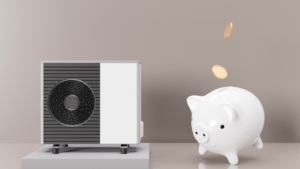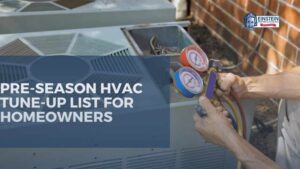A heat pump offers a sustainable and energy-efficient alternative to traditional heating and cooling methods. In this comprehensive guide tailored most especially for Phoenix residents, we will unravel the science behind how heat pumps operate, providing you with a clear understanding of the mechanics they bring to the table.
What is a heat pump?
Unlike traditional heating systems that generate heat, a heat pump operates on the principles of thermodynamics, facilitating the transfer of heat between the indoors and outdoors. At its core, a heat pump is a device that can function as both a heater and an air conditioner, providing a year-round solution for maintaining comfort in various environments.
One of the defining features of a heat pump is its ability to operate in two distinct modes: heating and cooling. During the colder months, the heat pump extracts heat from the outdoor air or the ground and transfers it indoors, providing warmth. In the warmer months, the process is reversed, with the heat pump expelling indoor heat to the outside environment, thereby cooling the indoor space.
How does it generate heat?
At the heart of a heat pump’s operation lies the fundamental concept of heat transfer. Instead of producing heat through combustion or resistance, as seen in conventional heating systems, a heat pump moves heat from one location to another. This process is accomplished by leveraging the principles of the refrigeration cycle, a dynamic sequence of events that facilitates the absorption and release of heat through the circulation of a refrigerant.
The Refrigeration Cycle Unveiled
The refrigeration cycle within a heat pump involves four key phases: compression, condensation, expansion, and evaporation. In the compression phase, a compressor pressurizes the refrigerant, causing it to become a high-temperature, high-pressure gas. This pressurized gas then flows to the condenser coil, typically located outside the indoor space.
- Condensation phase
During the condensation phase, the refrigerant releases heat to the surrounding outdoor air. This process transforms the refrigerant into a high-pressure liquid.
- Expansion phase
The expansion valve regulates the flow of the refrigerant, enabling it to transition into a low-pressure, low-temperature liquid. This prepared refrigerant then reaches the indoor evaporator coil.
- Evaporation phase
In the evaporation phase, the refrigerant absorbs heat from the indoor air or the ground, depending on the type of heat pump. This absorption of heat causes the refrigerant to evaporate, completing the cycle. The now low-pressure gas returns to the compressor to initiate the process once again. Through these continuous cycles, a heat pump efficiently transfers heat, serving as an effective means of both heating and cooling.
Variants of Heat Pumps: Air-Source and Ground-Source
Heat pumps come in two primary variants: air-source and ground-source (geothermal) heat pumps.
- Air-Source Heat Pumps: These units extract heat from the outdoor air, making them suitable for a wide range of climates. Despite potential efficiency challenges in extremely cold temperatures, advancements in technology have improved their performance, making them viable options in diverse environments.
- Ground-Source Heat Pumps (Geothermal Heat Pumps): Ground-source heat pumps leverage the stable temperature of the ground below the frost line. Through a network of underground pipes or wells, these heat pumps efficiently extract or dissipate heat, providing a consistent and reliable source of thermal energy. While installation costs may be higher, their efficiency in various climates makes them a sustainable long-term investment.
Components of a Heat Pump System
Evaporator Coil
Positioned indoors, the evaporator coil initiates the refrigeration cycle. In heating mode, this coil absorbs heat from the surrounding air or the ground, depending on the type of heat pump. This absorbed heat is then transferred to the refrigerant, setting the stage for the subsequent phases of the cycle.
Condenser Coil
The condenser coil, typically located outdoors, plays a crucial role in the heat exchange process. As the refrigerant travels through the system, it reaches the condenser coil, releasing the absorbed heat to the outdoor air during the heating cycle. This phase is essential for maintaining a continuous and efficient heat transfer process.
Compressor
Serving as the engine of the heat pump, the compressor is responsible for pressurizing the refrigerant. As the refrigerant is compressed, its temperature increases significantly, allowing it to release heat during the condensation phase. The compressor’s efficiency is pivotal in determining the overall performance of the heat pump system.
Expansion Valve
The expansion valve regulates the flow of the refrigerant, facilitating its transition from a high-pressure, high-temperature gas to a low-pressure, low-temperature liquid. This controlled expansion is a critical step in preparing the refrigerant for the subsequent evaporation process, ensuring optimal efficiency.
Efficiency of a Heat Pump
Coefficient of Performance (COP)
The efficiency of a heat pump is quantified by its Coefficient of Performance (COP), which represents the ratio of heat output to energy input. Higher COP values indicate greater efficiency, implying that the heat pump can transfer more heat with less energy consumption. Understanding and optimizing the COP is crucial for assessing and enhancing overall system performance.
How does COP for a heat pump work in Phoenix?
A homeowner in Phoenix is considering installing an air-source heat pump to address both heating and cooling needs. The outdoor air temperature during the cooling season often exceeds 100°F (37.8°C). The homeowner is interested in understanding the COP of the proposed heat pump during a typical summer day.
Given the following information:
- Outdoor air temperature: 100°F (37.8°C)
- Desired indoor temperature: 75°F (23.9°C)
- Heat extracted from indoor space: 24,000 BTU per hour
- Electrical power input to the heat pump: 6,000 watts
COP = Heat Output (BTU/hr) / Electrical power input (watts)
Given that 1 watt = 3.412 BTU/hr, we can convert the units accordingly.
COP=24,000BTU/hr / 6,000 watts x 1 watt / 3.412 BTU/hr
COP=7.035 / 3.412=2.06
The calculated COP of approximately 2.06 indicates that for every unit of electrical energy consumed, the heat pump can extract and transfer about 2.06 units of heat from the indoor space to the outdoor air. In the context of cooling, a COP above 1 signifies that the heat pump is more energy-efficient than a purely resistive heating element.
What does this mean?
In Phoenix’s extreme summer temperatures, achieving a COP above 2 demonstrates the heat pump’s effectiveness in providing cooling while minimizing electricity consumption. This emphasizes the energy efficiency of the heat pump, making it a viable and sustainable option for residents looking to combat heat while keeping energy costs in check.
It’s worth noting that the COP may vary based on specific heat pump models, environmental conditions, and system configurations.
Seasonal Energy Efficiency Ratio (SEER) and Heating Seasonal Performance Factor (HSPF)
SEER and HSPF are metrics that provide insights into the efficiency of air-source heat pumps. SEER measures cooling efficiency, while HSPF gauges heating efficiency. Higher SEER or HSPF values signify increased energy efficiency, helping consumers make informed decisions about the suitability of a heat pump for their specific heating and cooling needs.
Considerations for Installation and Maintenance
Proper Sizing
The effectiveness of a heat pump system is contingent on its proper sizing for the specific space it is intended to heat or cool. Undersized units may struggle to meet heating demands, leading to inefficient operation, while oversized units can result in short cycling and increased energy consumption. Proper sizing by HVAC professionals ensures optimal performance and energy efficiency.
Regular Maintenance
Routine maintenance is imperative to ensure the longevity and optimal performance of a heat pump. Tasks such as cleaning coils, checking refrigerant levels, and inspecting electrical components should be performed regularly by qualified technicians. This proactive approach not only extends the lifespan of the heat pump but also helps maintain its efficiency over time.

Advantages of a heat pump in Phoenix
1. Energy Efficiency:
Phoenix’s predominantly warm climate aligns well with the efficiency of heat pumps, particularly in their cooling mode. Heat pumps excel at extracting heat from the indoor space and expelling it outside during the hot months. This process is inherently more energy-efficient than traditional air conditioning systems that rely on electricity to cool indoor air.
2. Dual-Functionality:
Its dual functionality, offering both heating and cooling capabilities, has plenty of heat pump benefits for Phoenix residents. During the brief winter season, a heat pump can efficiently extract heat from the outdoor air and transfer it indoors, providing a cost-effective heating solution without the need for a separate heating system.
3. Lower Operating Costs:
In a region where air conditioning is a significant contributor to energy bills, heat pumps are energy efficient, and can result in lower operating costs. The ability to transfer heat rather than generate it, along with the potential for energy savings in both heating and cooling modes, makes heat pumps financially attractive for residents of Phoenix.
4. Reduced Carbon Footprint:
Heat pumps contribute to environmental sustainability by minimizing the reliance on fossil fuels for heating. In Phoenix, where the demand for cooling is substantial, the reduced electricity consumption during the cooling season translates to a lower overall carbon footprint compared to traditional heating and cooling systems.
Disadvantages of a heat pump in Phoenix
1. Reduced Efficiency in Extreme Heat:
One of the challenges faced by heat pumps in Phoenix is reduced efficiency during extreme heat conditions. As outdoor temperatures soar, the heat pump’s ability to extract heat from the already hot outdoor air diminishes. In such instances, supplementary cooling methods may be necessary to maintain indoor comfort, potentially increasing energy consumption.
2. Initial Installation Costs:
While heat pumps offer long-term savings, the initial installation costs can be higher compared to traditional HVAC systems, especially if additional modifications to the existing ductwork are required. Residents considering the switch to heat pumps need to weigh these upfront costs against the expected long-term benefits.
3. Dependency on Electricity:
Heat pumps, by nature, rely on electricity to operate. In a region where electricity consumption for cooling is already high, the increased reliance on electricity for both heating and cooling may raise concerns about grid demand during peak seasons. Homeowners must consider the local energy infrastructure and availability.
Conclusion
By seamlessly integrating fundamental thermodynamic principles, advanced refrigeration cycles, and adaptability to diverse environmental conditions, heat pumps have become indispensable in modern HVAC systems.
The energy efficiency, dual-functionality, and potential cost savings make heat pumps a compelling option for many residents or even business owners. Heat pump installation by experts at Einstein Heating and Cooling is important as it ensures that your heating system functions well. Ultimately, residents seeking an energy-efficient and versatile HVAC solution can find a valuable ally in a well-matched heat pump system.








